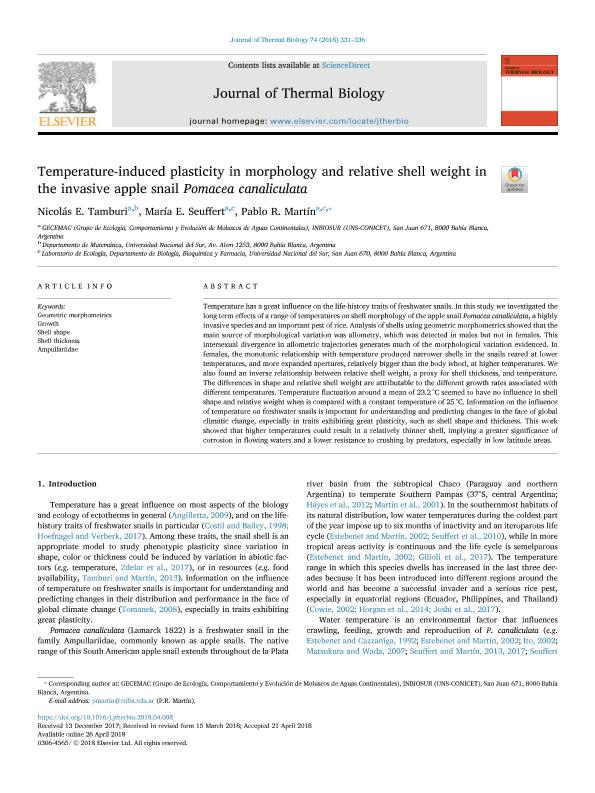Mostrar el registro sencillo del ítem
dc.contributor.author
Tamburi, Nicolas Eduardo

dc.contributor.author
Seuffert, Maria Emilia

dc.contributor.author
Martín, Pablo Rafael

dc.date.available
2019-11-05T17:20:32Z
dc.date.issued
2018-05
dc.identifier.citation
Tamburi, Nicolas Eduardo; Seuffert, Maria Emilia; Martín, Pablo Rafael; Temperature-induced plasticity in morphology and relative shell weight in the invasive apple snail Pomacea canaliculata; Pergamon-Elsevier Science Ltd; Journal of Thermal Biology; 74; 5-2018; 331-336
dc.identifier.issn
0306-4565
dc.identifier.uri
http://hdl.handle.net/11336/88026
dc.description.abstract
Temperature has a great influence on the life-history traits of freshwater snails. In this study we investigated the long term effects of a range of temperatures on shell morphology of the apple snail Pomacea canaliculata, a highly invasive species and an important pest of rice. Analysis of shells using geometric morphometrics showed that the main source of morphological variation was allometry, which was detected in males but not in females. This intersexual divergence in allometric trajectories generates much of the morphological variation evidenced. In females, the monotonic relationship with temperature produced narrower shells in the snails reared at lower temperatures, and more expanded apertures, relatively bigger than the body whorl, at higher temperatures. We also found an inverse relationship between relative shell weight, a proxy for shell thickness, and temperature. The differences in shape and relative shell weight are attributable to the different growth rates associated with different temperatures. Temperature fluctuation around a mean of 23.2 °C seemed to have no influence in shell shape and relative weight when is compared with a constant temperature of 25 °C. Information on the influence of temperature on freshwater snails is important for understanding and predicting changes in the face of global climatic change, especially in traits exhibiting great plasticity, such as shell shape and thickness. This work showed that higher temperatures could result in a relatively thinner shell, implying a greater significance of corrosion in flowing waters and a lower resistance to crushing by predators, especially in low latitude areas.
dc.format
application/pdf
dc.language.iso
eng
dc.publisher
Pergamon-Elsevier Science Ltd

dc.rights
info:eu-repo/semantics/openAccess
dc.rights.uri
https://creativecommons.org/licenses/by-nc-sa/2.5/ar/
dc.subject
AMPULLARIIDAE
dc.subject
GEOMETRIC MORPHOMETRICS
dc.subject
GROWTH
dc.subject
SHELL SHAPE
dc.subject
SHELL THICKNESS
dc.subject.classification
Ecología

dc.subject.classification
Ciencias Biológicas

dc.subject.classification
CIENCIAS NATURALES Y EXACTAS

dc.title
Temperature-induced plasticity in morphology and relative shell weight in the invasive apple snail Pomacea canaliculata
dc.type
info:eu-repo/semantics/article
dc.type
info:ar-repo/semantics/artículo
dc.type
info:eu-repo/semantics/publishedVersion
dc.date.updated
2019-10-24T18:19:05Z
dc.journal.volume
74
dc.journal.pagination
331-336
dc.journal.pais
Países Bajos

dc.journal.ciudad
Amsterdam
dc.description.fil
Fil: Tamburi, Nicolas Eduardo. Consejo Nacional de Investigaciones Científicas y Técnicas. Centro Científico Tecnológico Conicet - Bahía Blanca. Instituto de Ciencias Biológicas y Biomédicas del Sur. Universidad Nacional del Sur. Departamento de Biología, Bioquímica y Farmacia. Instituto de Ciencias Biológicas y Biomédicas del Sur; Argentina. Universidad Nacional del Sur. Departamento de Matemática; Argentina
dc.description.fil
Fil: Seuffert, Maria Emilia. Consejo Nacional de Investigaciones Científicas y Técnicas. Centro Científico Tecnológico Conicet - Bahía Blanca. Instituto de Ciencias Biológicas y Biomédicas del Sur. Universidad Nacional del Sur. Departamento de Biología, Bioquímica y Farmacia. Instituto de Ciencias Biológicas y Biomédicas del Sur; Argentina
dc.description.fil
Fil: Martín, Pablo Rafael. Consejo Nacional de Investigaciones Científicas y Técnicas. Centro Científico Tecnológico Conicet - Bahía Blanca. Instituto de Ciencias Biológicas y Biomédicas del Sur. Universidad Nacional del Sur. Departamento de Biología, Bioquímica y Farmacia. Instituto de Ciencias Biológicas y Biomédicas del Sur; Argentina
dc.journal.title
Journal of Thermal Biology

dc.relation.alternativeid
info:eu-repo/semantics/altIdentifier/url/https://www.sciencedirect.com/science/article/pii/S0306456517305247
dc.relation.alternativeid
info:eu-repo/semantics/altIdentifier/doi/http://dx.doi.org/10.1016/j.jtherbio.2018.04.008
Archivos asociados
